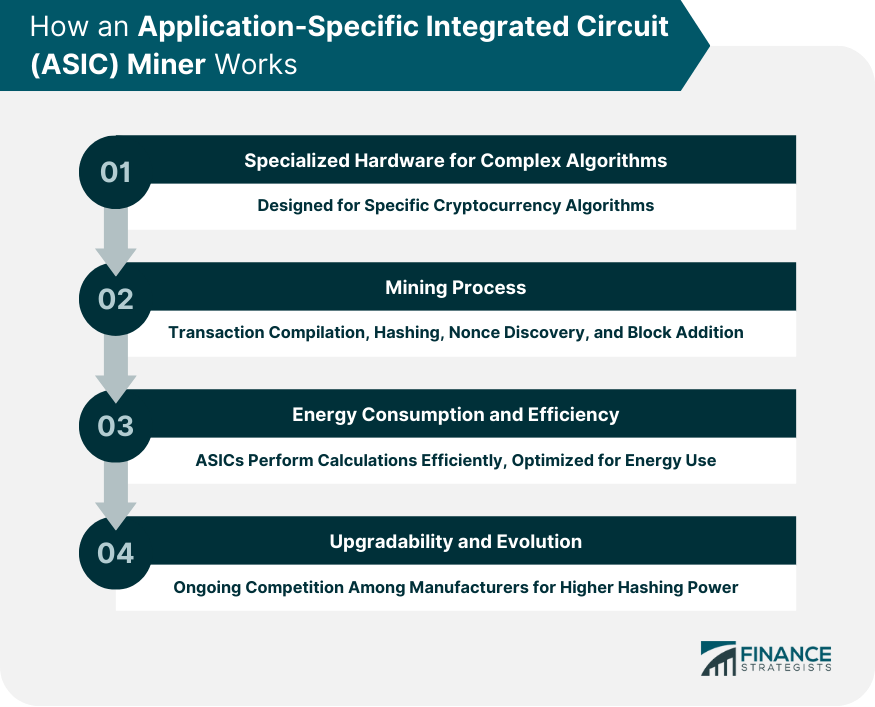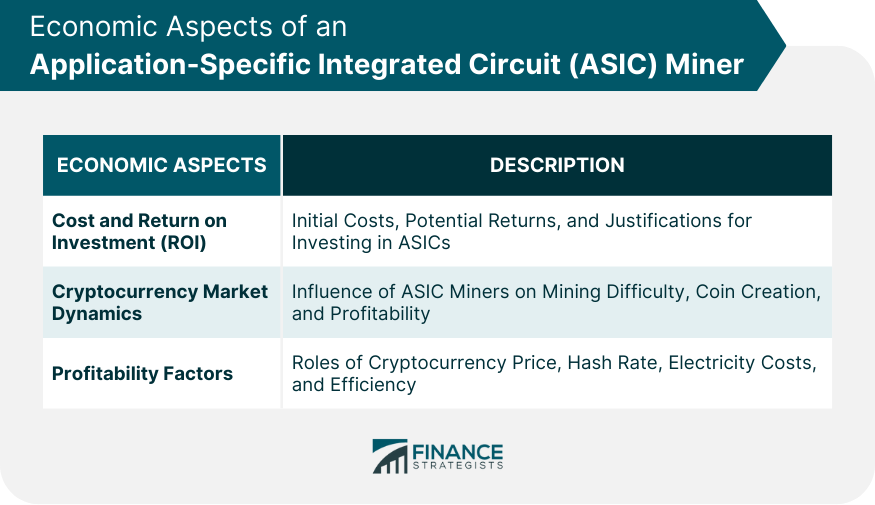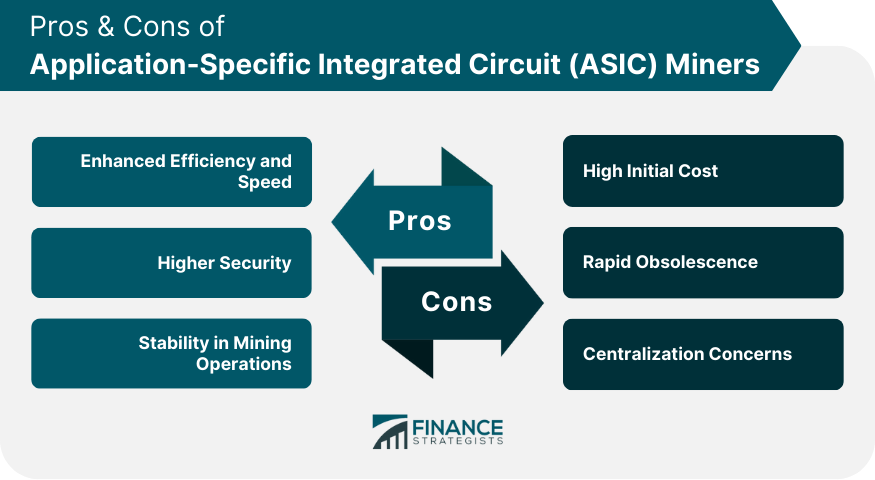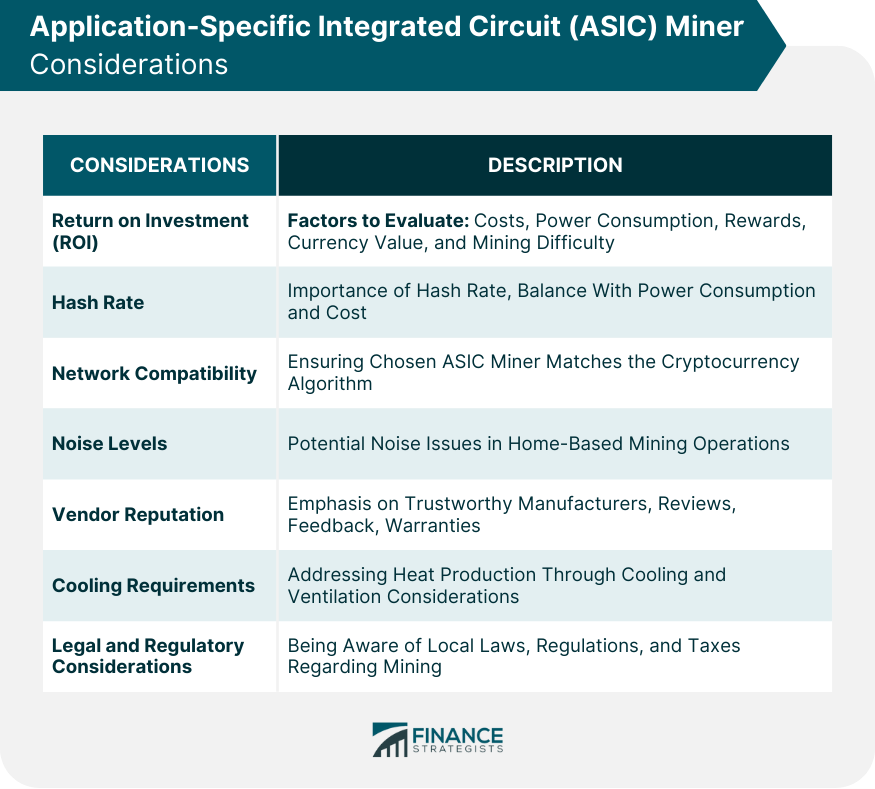An Application-Specific Integrated Circuit (ASIC) Miner is a custom-tailored piece of hardware specifically designed for a singular task. In the realm of cryptocurrency, this task pertains to the computations required for mining operations. This focus on a single function allows them to outperform general-purpose hardware in terms of speed and energy efficiency when it comes to cryptocurrency mining. Their introduction has brought a shift from casual, individual mining activities performed with standard computer hardware to more professional, large-scale operations that leverage the superior power of ASICs. This evolution has significantly raised the bar in terms of mining efficiency, making the cryptocurrency mining landscape more competitive. It has also led to a surge in mining power, enhancing the overall security and robustness of various cryptocurrency networks. Every cryptocurrency operates on a specific algorithm. An ASIC miner designed for mining Bitcoin is specially built to handle the SHA-256 hashing function and nothing else. Because of this specialized design, the ASIC miner can process these calculations at unparalleled speeds, far surpassing what a regular computer or graphics card could achieve. Transaction Compilation: The first step involves collecting several pending transactions into a memory pool or 'mempool'. These transactions are waiting to be included in the next block. Proof-Of-Work Challenge: Next, the ASIC miner takes a collection of these transactions and starts the process of hashing them. In essence, it's attempting to find a specific value (a nonce) that, when hashed with the transaction data, produces a hash output that meets specific criteria set by the network, such as having a certain number of leading zeros. Hashing at Lightning Speed: The miner will make countless hashing attempts per second, changing the nonce value with each attempt, to find the right one that meets the network's criteria. Given the number of potential nonce values, this is where the ASIC's raw power shines, as it can perform these hashes exponentially faster than general computing hardware. Solution and Block Addition: Once the ASIC miner successfully finds a nonce that produces the desired hash, it broadcasts its solution to the rest of the network. Other nodes will quickly verify the solution, and once a consensus is reached, the new block (containing the selected transactions) is added to the blockchain. The number of calculations that an ASIC miner performs every second demands significant power. However, the advantage of ASIC miners over traditional computing hardware is their enhanced energy efficiency per calculation. Since they're tailored for a single purpose, their architecture is optimized to conduct their specific task using the least amount of energy possible. This efficiency is a crucial factor when considering the profitability of a mining operation, as electricity costs can eat significantly into potential profits. As more miners join a network, the difficulty of the mathematical problems increases, necessitating more powerful and efficient ASICs. Consequently, there's a continuous race among ASIC manufacturers to design chips with higher hashing power while retaining energy efficiency. This perpetual evolution ensures that the ASIC miners remain at the forefront of cryptocurrency mining technology. Investing in ASIC miners requires a sizable upfront capital. The hardware itself can be expensive, and additional costs such as electricity, cooling, and maintenance also factor into the total investment. However, the potential returns can be significant. With the heightened efficiency of ASIC miners, they can mine cryptocurrencies at a rate that can offer a favorable return on investment, especially in environments with lower electricity costs. Despite the high initial costs, many miners find that the long-term rewards, especially during cryptocurrency bull markets, justify the investment. The dominance of ASIC miners in the crypto mining landscape has led to an increase in the mining difficulty for various cryptocurrencies. As more and more potent miners participate in the network, the mathematical problems they need to solve become harder, ensuring that the rate of new coin creation remains relatively constant. This dynamic has made it challenging for less potent mining methods to remain profitable. In essence, ASIC miners have shaped and will continue to influence the trajectory and scalability of various cryptocurrency networks. The price of the cryptocurrency being mined, the total hash rate of the network, electricity costs, and the efficiency of the miner itself all play crucial roles. An increase in the currency's price or a decrease in electricity costs can boost profitability, while a surge in the network's total hash rate or an increase in electricity costs can diminish returns. Miners must keep a vigilant eye on these ever-shifting variables to ensure consistent profitability. Given their purpose-built nature, they can execute mining tasks at a much faster rate than general-purpose hardware. This rapidity translates to more blocks mined in a shorter time frame, which can lead to increased rewards for miners using ASICs. For major cryptocurrencies like Bitcoin, where mining competition is fierce, this efficiency can mean the difference between profitability and operating at a loss. ASIC miners contribute to the security of cryptocurrency networks. Their immense hashing power ensures that malicious entities find it difficult to execute a 51% attack on the network. By bolstering the network's security, they indirectly contribute to the trust and credibility of the cryptocurrency itself. Unlike other mining methods that may become obsolete quickly, ASIC miners, given their specialized focus, can remain relevant for more extended periods. This means miners don't frequently need to upgrade or swap out hardware, ensuring a more consistent mining operation. Such stability is especially beneficial when considering long-term financial planning. One of the primary barriers to entry in ASIC mining is the initial cost. These devices, given their specialized nature, come with a hefty price tag. For individuals or entities new to mining, this can pose a significant challenge, especially when combined with other associated costs like energy and setup. A top-of-the-line ASIC miner today might become outdated within a year or two, as newer, more potent models emerge. This rapid cycle of obsolescence means that miners must continuously invest in new hardware to remain competitive. The dominance of ASIC miners, combined with their high costs, has led to mining centralization. Large mining farms and pools now control significant portions of the total network hash rate for various cryptocurrencies. This concentration poses potential risks to the security and democratic nature of these networks. Embarking on the journey of cryptocurrency mining using ASICs demands thorough research, and an understanding of both the benefits and challenges presented by this specialized hardware. Here are some key considerations to keep in mind: Return on Investment (ROI): Evaluate the costs of the miner, power consumption, and the current reward. Factor in potential fluctuations in the currency's value and the increasing difficulty of mining over time. Hash Rate: A higher hash rate generally translates to increased chances of finding the next block in a blockchain. However, it's essential to weigh this against power consumption and cost. Network Compatibility: Ensure that the chosen ASIC miner is compatible with the cryptocurrency you aim to mine. Not all ASIC miners are designed for every cryptocurrency algorithm. Noise Levels: Some ASIC miners can be particularly noisy, which might be problematic for home-based operations. If you're considering mining in a residential setting, take the noise factor into account. Vendor Reputation: Unfortunately, the crypto industry is not immune to scams or subpar products. It's essential to purchase from reputable manufacturers and vendors. Look for reviews, customer feedback, and warranty or return policies. Cooling Requirements: ASIC miners can produce a lot of heat. Depending on the model and your setup, additional cooling or ventilation might be required. Factor in these additional equipment and operational costs. Legal and Regulatory Considerations: Cryptocurrency mining is heavily regulated, taxed, or even banned. Before investing in hardware, ensure you're familiar with the local laws pertaining to mining and cryptocurrency operations. ASIC miner has revolutionized cryptocurrency mining. By focusing on a single task, ASICs have proven their superiority in terms of speed and energy efficiency, driving a shift from individual to professional mining operations. ASIC miners operate by swiftly handling complex algorithms, significantly outperforming traditional hardware. Their lightning-fast hashing ability ensures the quick compilation of transactions and successful proof-of-work challenges. While ASICs offer benefits like efficiency, security enhancement, and operational stability, they also present challenges. High initial costs, rapid obsolescence, and centralization concerns are noteworthy drawbacks. Success in ASIC mining requires thorough research, considering ROI, hash rate, network compatibility, noise levels, vendor reputation, cooling, and legal aspects. In shaping cryptocurrency markets, ASIC miners have spurred competition, influenced network dynamics, and solidified security. Their significance underscores the delicate balance between innovation and its economic and regulatory implications.What Is an Application-Specific Integrated Circuit (ASIC) Miner?
How an ASIC Miner Works
Specialized Hardware for Complex Algorithms
Mining Process
Energy Consumption and Efficiency
Upgradability and Evolution

Economic Aspects of an ASIC Miner
Cost and Return on Investment (ROI)
Cryptocurrency Market Dynamics
Profitability Factors

Pros of ASIC Miners
Enhanced Efficiency and Speed
Higher Security
Stability in Mining Operations
Cons of ASIC Miners
High Initial Cost
Rapid Obsolescence
Centralization Concerns

ASIC Miner Considerations

Conclusion
Application-Specific Integrated Circuit (ASIC) Miner FAQs
An ASIC miner, short for Application-Specific Integrated Circuit miner, is specialized hardware designed solely for cryptocurrency mining tasks.
An ASIC miner operates by swiftly processing complex algorithms specific to a cryptocurrency's hashing function, enabling rapid transaction verification and block creation.
ASIC miners are tailored for a single task, making them significantly faster and energy-efficient in cryptocurrency mining compared to general-purpose devices.
ASIC miners offer enhanced efficiency, faster mining speeds, higher security through hashing power, and stable, specialized operations for extended periods.
Yes, ASIC miners come with high initial costs, risk of rapid obsolescence due to evolving technology, and concerns about mining centralization in the hands of large operations.
True Tamplin is a published author, public speaker, CEO of UpDigital, and founder of Finance Strategists.
True is a Certified Educator in Personal Finance (CEPF®), author of The Handy Financial Ratios Guide, a member of the Society for Advancing Business Editing and Writing, contributes to his financial education site, Finance Strategists, and has spoken to various financial communities such as the CFA Institute, as well as university students like his Alma mater, Biola University, where he received a bachelor of science in business and data analytics.
To learn more about True, visit his personal website or view his author profiles on Amazon, Nasdaq and Forbes.











